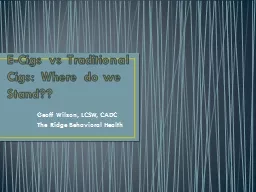PPT-E-Cigs vs Traditional
Author : karlyn-bohler | Published Date : 2016-08-16
Cigs Where do we Stand Geoff Wilson LCSW CADC The Ridge Behavioral Health Are We Still Concerned Cigarette smoking is the leading cause of preventable disease
Presentation Embed Code
Download Presentation
Download Presentation The PPT/PDF document "E-Cigs vs Traditional" is the property of its rightful owner. Permission is granted to download and print the materials on this website for personal, non-commercial use only, and to display it on your personal computer provided you do not modify the materials and that you retain all copyright notices contained in the materials. By downloading content from our website, you accept the terms of this agreement.
E-Cigs vs Traditional: Transcript
Download Rules Of Document
"E-Cigs vs Traditional"The content belongs to its owner. You may download and print it for personal use, without modification, and keep all copyright notices. By downloading, you agree to these terms.
Related Documents














